The HR Leader's Guide to Using AI in Recruiting
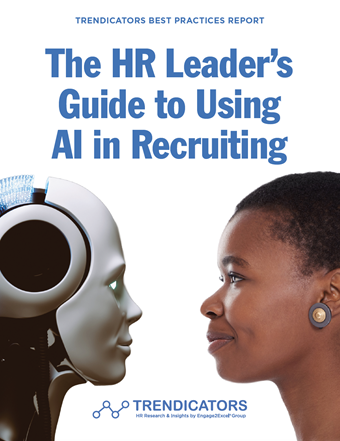
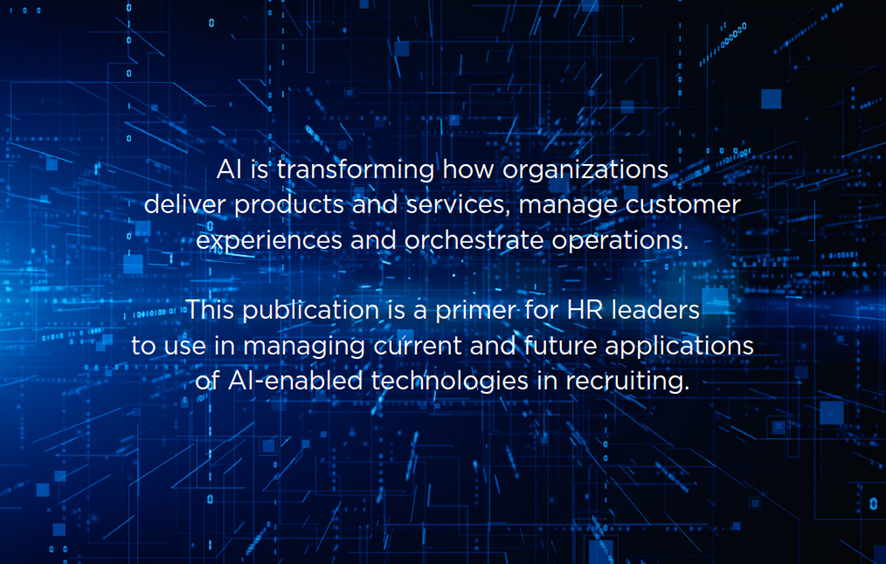
DISCLAIMER: This eBook contains information intended to guide HR executives interested in learning more about AI-enabled recruiting tools and platforms. When implementing AI platforms or tools within your organization, it is essential to engage key stakeholders from the IT, legal, finance, procurement and compliance teams.
Introduction
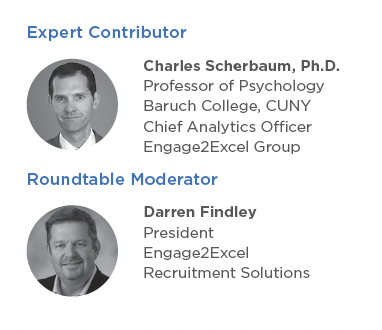 AI’s role in recruiting must first be examined through the lens of how such technology has reshaped the talent acquisition landscape. Early versions (1990s) of AI in applicant tracking systems (ATS) were used in keyword matching to help recruiters sift through large volumes of applications. As computational processing power improved exponentially one decade later, machine learning algorithms and natural language processing led to the use of predictive analytics for candidate assessment and sentiment analysis, which enabled recruiters to gain deeper insights into candidates’ personalities and cultural fits.
AI’s role in recruiting must first be examined through the lens of how such technology has reshaped the talent acquisition landscape. Early versions (1990s) of AI in applicant tracking systems (ATS) were used in keyword matching to help recruiters sift through large volumes of applications. As computational processing power improved exponentially one decade later, machine learning algorithms and natural language processing led to the use of predictive analytics for candidate assessment and sentiment analysis, which enabled recruiters to gain deeper insights into candidates’ personalities and cultural fits.
Today, AI in recruitment involves the application of artificial intelligence and machine learning algorithms to automate and improve recruiting functions—from candidate sourcing and assessment to candidate engagement, interviewing and hiring decision support.
The question is not whether AI will transform recruiting processes—it already has. This publication explores a top-of-mind question for HR leaders: What can be done to ensure the responsible, equitable and legally compliant application of AI to streamline workflows, save time, enable more efficient resource utilization and improve the quality of hires?
In a recent roundtable session with members of the Trendicators Advisory Board, we addressed that question. Dr. Charles Scherbaum, Engage2Excel’s chief analytics officer and professor of psychology at Baruch College, City University of New York, led the discussion. Dr. Scherbaum has worked as an expert in employment litigation. He has provided advice and guidance for several class action settlements and federal consent decrees related to discrimination in hiring, compensation and performance assessment.
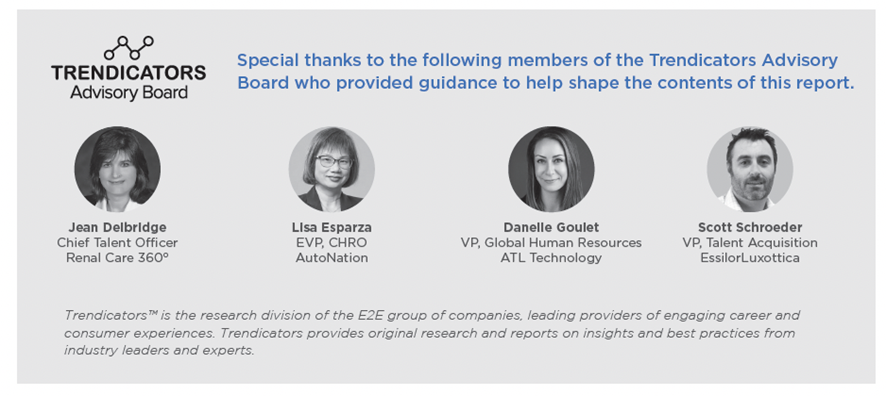
Download
 hbspt.cta.load(123973, '21153941-4783-4919-89d2-52e4010a0269', {"useNewLoader":"true","region":"na1"});
hbspt.cta.load(123973, '21153941-4783-4919-89d2-52e4010a0269', {"useNewLoader":"true","region":"na1"});
The Current State of AI in Recruiting
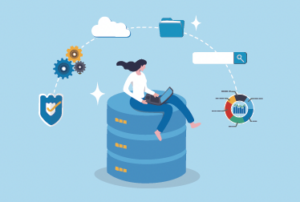 According to recent research by the Society for Human Resource Management (SHRM), about 1 in 4 organizations currently use AI to support HR-related activities. However, most of those organizations began using the technology within HR during the prior 12 months. In January 2024, the SHRM survey revealed that using AI to support HR organizations had become more of a priority within the last year. While AI proponents cite numerous advantages, significant risks and barriers to adoption exist.
According to recent research by the Society for Human Resource Management (SHRM), about 1 in 4 organizations currently use AI to support HR-related activities. However, most of those organizations began using the technology within HR during the prior 12 months. In January 2024, the SHRM survey revealed that using AI to support HR organizations had become more of a priority within the last year. While AI proponents cite numerous advantages, significant risks and barriers to adoption exist.
Today, chatbots, virtual assistants and sourcing platforms are becoming increasingly prevalent in the early stages of the recruitment process. These AI tools can answer common queries from candidates, schedule interviews, help identify new candidate pools, and automate other tasks to increase efficiency and optimize resources in talent acquisition. When held to well-established standards for ensuring fairness in HR processes, these tools can also help to standardize interviewing and selection processes to minimize bias and increase diversity. This, however, will require greater levels of transparency from AI solution providers than exists today. The greatest concerns for HR leaders are legal and regulatory risks, which are discussed on page 9. Ultimately, realizing the full potential of AI in recruiting will require integration with other enterprise systems and the ability to move from exclusive reliance on large language models to customization of algorithms to adapt to organizational policies, cultures and needs.
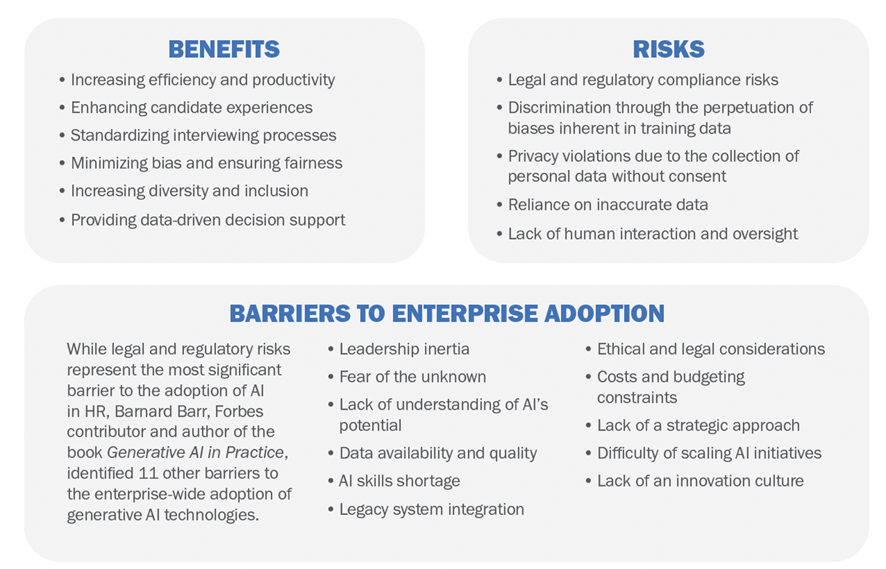
Download
 hbspt.cta.load(123973, '21153941-4783-4919-89d2-52e4010a0269', {"useNewLoader":"true","region":"na1"});
hbspt.cta.load(123973, '21153941-4783-4919-89d2-52e4010a0269', {"useNewLoader":"true","region":"na1"});
Overview of AI Use Cases & Benefits
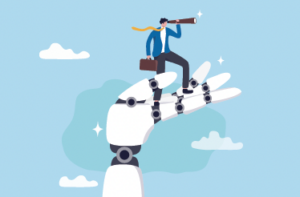 While most employers are still evaluating the use of AI in recruiting processes, AI adoption is expected to increase significantly over the next several years as recruiting teams gain a better understanding of how AI can be leveraged to improve recruiting efficiency and effectiveness. According to MMR, a market research firm serving Fortune 500 companies, the AI recruitment market, valued at $661M in 2023, is estimated to reach $1.1B by 2030.
While most employers are still evaluating the use of AI in recruiting processes, AI adoption is expected to increase significantly over the next several years as recruiting teams gain a better understanding of how AI can be leveraged to improve recruiting efficiency and effectiveness. According to MMR, a market research firm serving Fortune 500 companies, the AI recruitment market, valued at $661M in 2023, is estimated to reach $1.1B by 2030.

The following is an overview of AI’s use cases and benefits in talent acquisition. It is a starting point for HR executives seeking to learn more about integrating AI into talent acquisition processes.
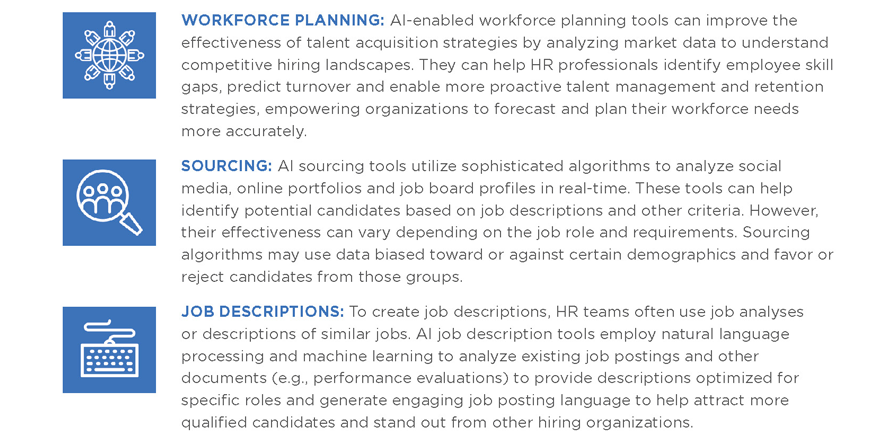
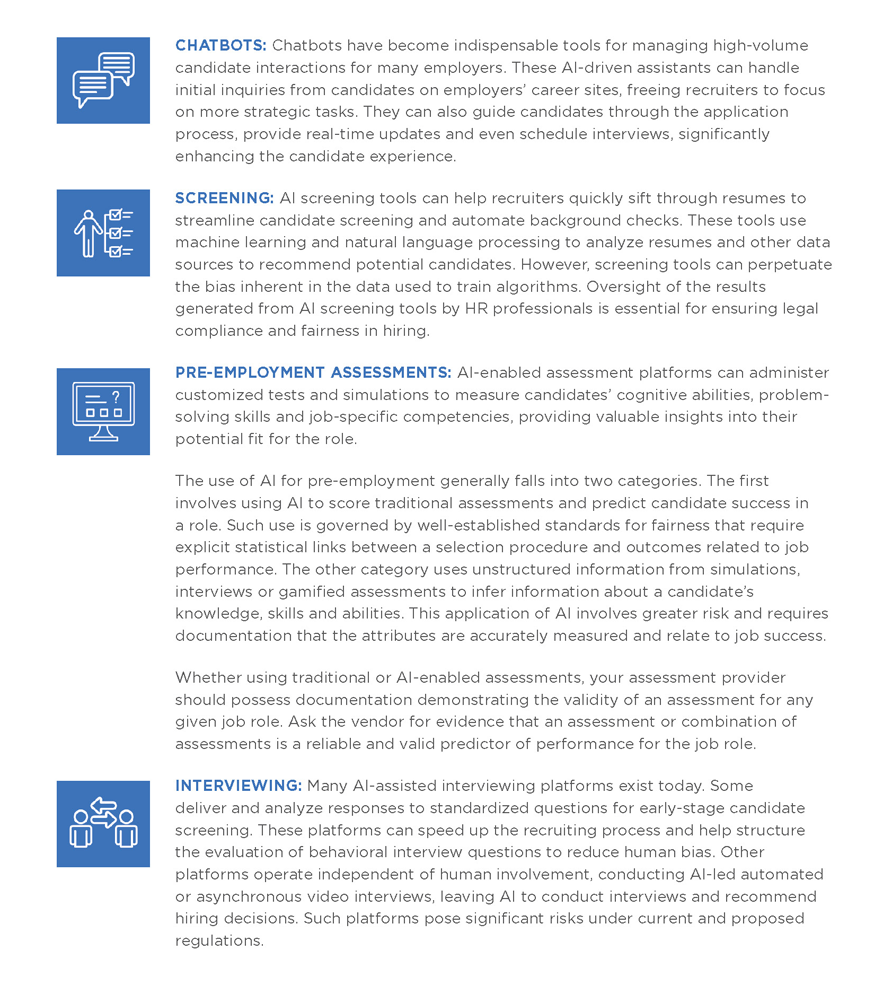
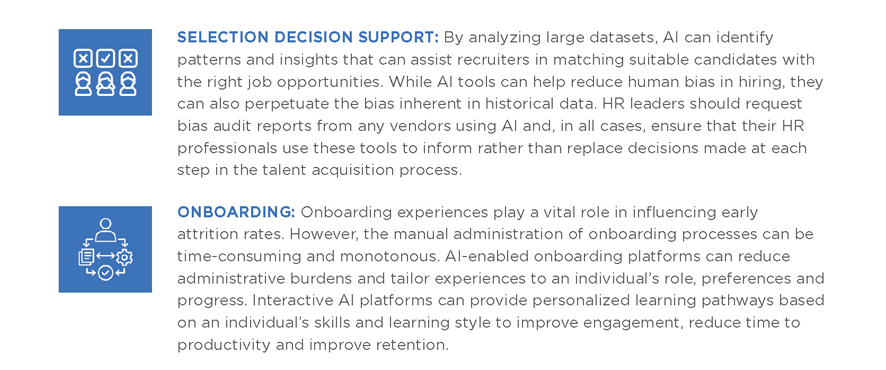
Download
 hbspt.cta.load(123973, '21153941-4783-4919-89d2-52e4010a0269', {"useNewLoader":"true","region":"na1"});
hbspt.cta.load(123973, '21153941-4783-4919-89d2-52e4010a0269', {"useNewLoader":"true","region":"na1"});
Profiles of AI Use in Recruiting
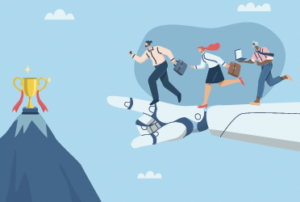 How are industry-leading brands using AI in recruiting? The following profiles, based on reports from AI platform providers, reveal the use of AI to streamline recruitment processes, facilitate good candidate experiences and improve skill matching with open opportunities. The degree to which companies report the use of AI on career websites varies and is sometimes included in FAQs. All companies listed include detailed information about using, storing and protecting personal information in privacy disclosures.
How are industry-leading brands using AI in recruiting? The following profiles, based on reports from AI platform providers, reveal the use of AI to streamline recruitment processes, facilitate good candidate experiences and improve skill matching with open opportunities. The degree to which companies report the use of AI on career websites varies and is sometimes included in FAQs. All companies listed include detailed information about using, storing and protecting personal information in privacy disclosures.
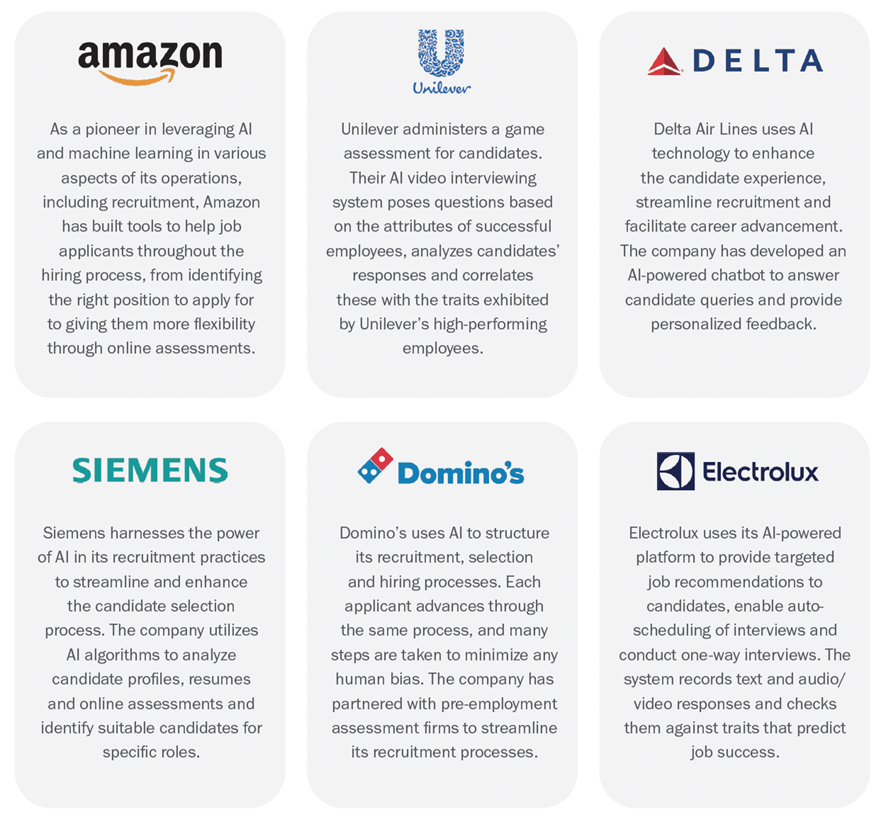
Download
 hbspt.cta.load(123973, '21153941-4783-4919-89d2-52e4010a0269', {"useNewLoader":"true","region":"na1"});
hbspt.cta.load(123973, '21153941-4783-4919-89d2-52e4010a0269', {"useNewLoader":"true","region":"na1"});
Regulatory & Legal Risks
 The use of AI in hiring has come under increased regulatory scrutiny over the past several years. While the U.S. has no federal regulations in place, states and municipalities are quickly moving to enact legislation that affects employers and software vendors. Currently, 16 states have legislated and passed AI regulations. Over the past year, state-level AI-related bills have increased by 1,600% and now exceed 400 in number. Navigating these complex requirements is even more difficult for companies operating internationally.
The use of AI in hiring has come under increased regulatory scrutiny over the past several years. While the U.S. has no federal regulations in place, states and municipalities are quickly moving to enact legislation that affects employers and software vendors. Currently, 16 states have legislated and passed AI regulations. Over the past year, state-level AI-related bills have increased by 1,600% and now exceed 400 in number. Navigating these complex requirements is even more difficult for companies operating internationally.
On August 1, 2024, the European Parliament published the long-awaited final version of the AI Act, which treats employers’ use of AI in the workplace as a potentially high risk. The act imposes obligations for AI use along with potential penalties for violations. The legislation will be implemented incrementally over the next three years. Although it only applies to organizations operating in the European Union, the AI Act is expected to provide a baseline for other countries, including similar regulations in Canada, India and China.
Managing Regulatory and Legal Risks
One of AI’s most significant advantages in hiring is its ability to automate the analysis of massive amounts of structured and unstructured data. However, collecting and analyzing this information for use in selection and hiring decisions raises privacy, compliance and legal concerns. Dr. Scherbaum, who has served as an expert in employment litigation and class action cases, offered the following recommendations for employers to use in navigating the risks associated with using AI in hiring processes. Consult with legal counsel to obtain information on compliance requirements specific to your company.
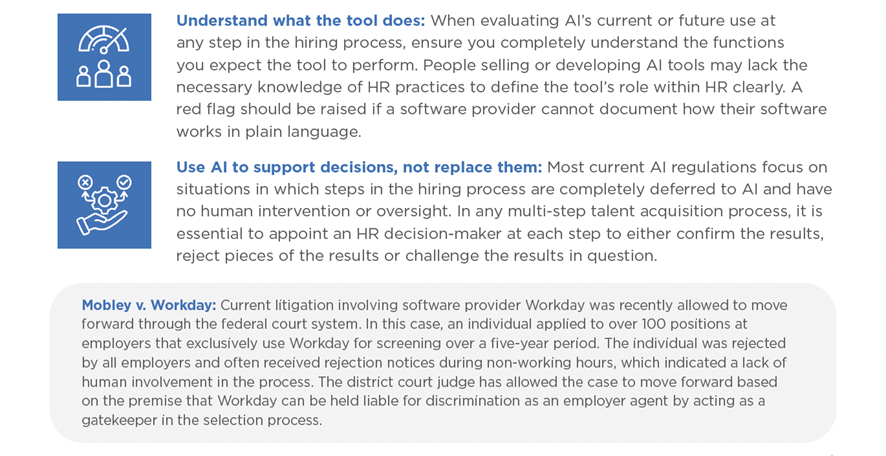
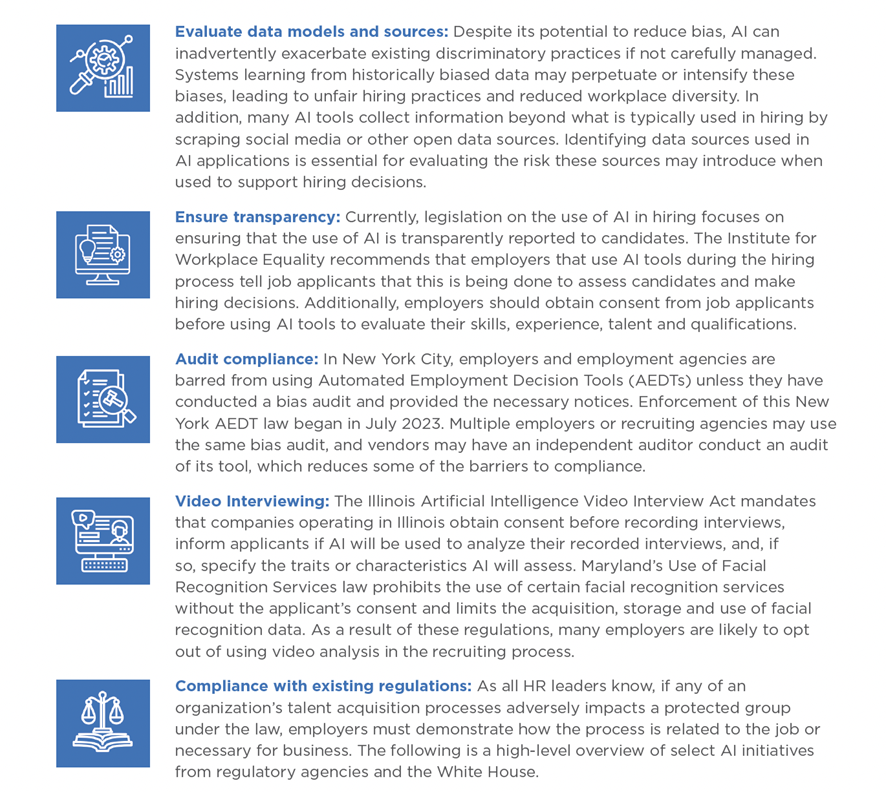


Download
 hbspt.cta.load(123973, '21153941-4783-4919-89d2-52e4010a0269', {"useNewLoader":"true","region":"na1"});
hbspt.cta.load(123973, '21153941-4783-4919-89d2-52e4010a0269', {"useNewLoader":"true","region":"na1"});
Candidate Perceptions
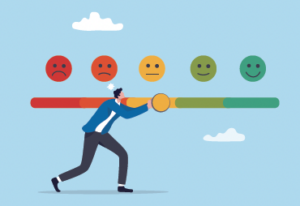 Not surprisingly, many candidates are skeptical about using AI in recruitment and hiring processes. People do not trust what they do not understand. In reviewing the results of surveys about perceptions of AI in hiring, it is important to distinguish between those that assess general perceptions and those that assess perceptions based on the actual use of AI in hiring processes. The following is an overview of the results of two studies on this topic. Your best source of research will come from surveying your company’s job applicants.
Not surprisingly, many candidates are skeptical about using AI in recruitment and hiring processes. People do not trust what they do not understand. In reviewing the results of surveys about perceptions of AI in hiring, it is important to distinguish between those that assess general perceptions and those that assess perceptions based on the actual use of AI in hiring processes. The following is an overview of the results of two studies on this topic. Your best source of research will come from surveying your company’s job applicants.
A 2022 study by the Pew Research Center revealed that 62% of the respondents would not apply for a job with an employer that uses AI to help make hiring decisions. By contrast, the use of AI by an employer would not deter 32% of those surveyed from applying. The same survey reported that 47% of the respondents said AI would be good at treating all applicants objectively, but they felt that AI, compared to a human, would be worse at seeing someone’s potential.
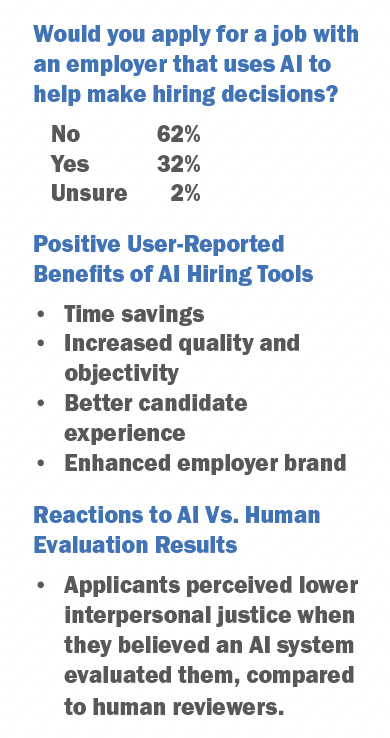 A study published in Computers in Human Behavior titled “Applicants’ Perception of Artificial Intelligence in the Recruitment Process” analyzed respondents’ reactions to AI recruitment tools in a simulation of AI-enabled application processes. Most participants (69%) agreed that AI reduces response time and is fast and efficient when used correctly. Almost half of the respondents confirmed that AI tools are easy to use, intuitive, self-explanatory and convenient and that AI technology generally works well. The results also showed that applicants perceived less favorable personal treatment when they believed an AI system evaluated them than when human reviewers did. However, there were no differences in the fairness of the process between the AI and HR conditions.
A study published in Computers in Human Behavior titled “Applicants’ Perception of Artificial Intelligence in the Recruitment Process” analyzed respondents’ reactions to AI recruitment tools in a simulation of AI-enabled application processes. Most participants (69%) agreed that AI reduces response time and is fast and efficient when used correctly. Almost half of the respondents confirmed that AI tools are easy to use, intuitive, self-explanatory and convenient and that AI technology generally works well. The results also showed that applicants perceived less favorable personal treatment when they believed an AI system evaluated them than when human reviewers did. However, there were no differences in the fairness of the process between the AI and HR conditions.
Key Takeaways: The contrast between these survey results is important for HR leaders contemplating using or are already using AI in recruiting. The popular perception, as illustrated in the Pew Research Center study, is that AI would dissuade candidates from applying. However, experience-based testing and the widespread use of AI by large employers demonstrate many positive benefits when AI is used responsibly.
It is important to note that when applicants believe that they have been rejected by an AI tool, they doubt the fairness of the procedure more than if they are rejected by a human. Concerns over racial bias may also make minority applicants wary of AI rejections. These results underscore the importance of conducting bias audits, human engagement with candidates and clear communication about how selection and hiring decisions are made.
Download
 hbspt.cta.load(123973, '21153941-4783-4919-89d2-52e4010a0269', {"useNewLoader":"true","region":"na1"});
hbspt.cta.load(123973, '21153941-4783-4919-89d2-52e4010a0269', {"useNewLoader":"true","region":"na1"});
Roundtable Q&A
The following are excerpts from a Q&A session between Dr. Scherbaum and members of the Trendicators Advisory Board.
What is your outlook on the future of AI in helping employers improve fairness in hiring? I believe it is possible to use AI to increase fairness in hiring decisions. The obvious benefits are efficiency and automation. AI can do things much faster and more easily on a scale that humans could ever do. Regarding fairness, AI can introduce standardization in areas with the highest degree of subjectivity. Any time you can reduce the amount of subjectivity in a process, that is a good thing. AI imposes process and structure onto subjective recruitment phases, representing an advantage from a defensibility standpoint.
However, because AI has come under increased regulatory scrutiny, employers face increased risks. Also, the ultimate fairness of any AI tool will depend on the datasets used to train the model. Improvements in fairness can only be achieved if the underlying data reflect fair and equitable decisions and outcomes.
In volume hiring, human bias is unavoidable but not subject to the same legal risks as when AI is involved. Why is that? In a class action suit against an employer, potential class members must have all suffered an action or inaction that arose from a common set of facts. In Mobley v. Workday, this criterion was met because the class members were all subject to the same standardized process for selection or rejection by an AI application. In contrast, while hiring managers at different locations may make personally biased hiring decisions, such a situation is less likely to qualify for a class action suit. While AI can help improve hiring fairness through standardization, it could be a double-edged sword. We are just beginning to understand the many trade-offs involved in applying AI in hiring.
Can AI be used to audit traditional hiring practices? AI could prove useful in auditing hiring processes. But today, we’re still using humans to do the auditing. In addition to statistical models, we are looking at processes and data in the context of their use. For example, part of a broader audit could examine the locations of in-person interviews or testing. A test or interview might be fair, but the locations may not be accessible by public transportation. This could exclude large groups of people from the pool of candidates. Experts look beyond just the results of statistical analyses to determine the context for evaluating fairness—whether AI is involved or not.
In your opinion, what applications of AI have the lowest level of risk with the greatest immediate benefit? There are three areas today where AI can save time, improve candidate experiences and improve hiring success with the least amount of risk. These are job descriptions, candidate communications and workforce planning.
There is promising work on using AI to conduct job analyses and create job descriptions. A lack of job analysis is the Achilles’ heel in any litigation against an employer because employers often don’t take the time to do it. Almost every accepted way of demonstrating the job-relatedness of a hiring process relies on a job analysis.
AI can also help facilitate better candidate communication. For example, if a candidate has not been scheduled for an interview within a certain number of days, an AI system can send a note saying, “You’re still in consideration. The position is still open. We will be in touch soon. We really hope you continue to be interested.”
Finally, workforce planning can greatly benefit from AI. AI-powered systems can analyze historical data, market trends and business objectives to help predict future demand, identify skill gaps and recommend possible workforce adjustments.
Download
 hbspt.cta.load(123973, '21153941-4783-4919-89d2-52e4010a0269', {"useNewLoader":"true","region":"na1"});
hbspt.cta.load(123973, '21153941-4783-4919-89d2-52e4010a0269', {"useNewLoader":"true","region":"na1"});